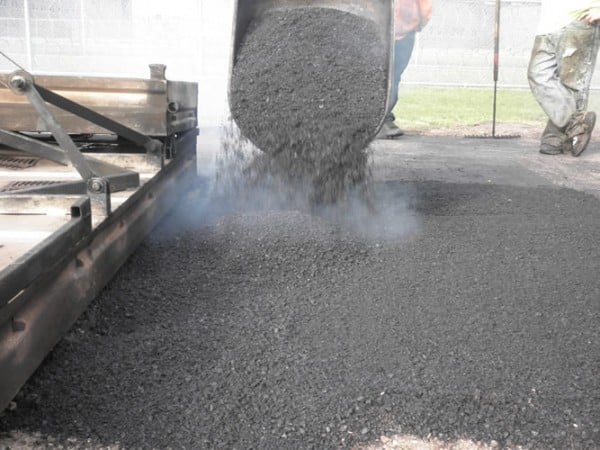Maximize Room Efficiency with Hot Mix Asphalt Angled Parking Lot Solutions
Wiki Article
Opening the Secrets of Hot Mix Asphalt Innovation
Checking out the midsts of hot mix asphalt innovation reveals a globe where meticulous procedures and precise formulations assemble to form our roadways and framework. The blend of fillers, binders, and aggregates isn't simply a building task yet a critical orchestration of resilience and efficiency. As we peer right into the intricate dance of parts, a tapestry of strength and sustainability unfolds. What lies beneath this surface area of asphaltic mastery, and what keys wait to be introduced in the world of paving technologies?Significance of Hot Mix Asphalt
Warm Mix Asphalt plays a critical role in modern infrastructure advancement due to its sturdiness and cost-effectiveness. As the most typically used paving material for roads, highways, and car parking whole lots, Warm Mix Asphalt supplies an array of advantages that contribute to its relevance in construction tasks.The durability of Hot Mix Asphalt stems from its composition, which includes accumulations, binder, and filler products that are very carefully selected and mixed to meet specific performance needs. This specific combination causes a solid and adaptable pavement that can endure frequent usage without substantial deterioration. Hot Mix Asphalt is 100% recyclable, additional improving its sustainability and environmental advantages. Generally, the relevance of Warm Mix Asphalt in facilities development can not be underrated, as it proceeds to be a cornerstone of contemporary construction techniques.
Components of Asphalt Mixes
The structure of asphalt blends is composed of thoroughly chosen accumulations, binder, and filler products that are essential for accomplishing details performance requirements. Accumulations are the key part of asphalt mixes, supplying strength and stability. The binder, normally bitumen or asphalt concrete, holds the accumulations with each other and gives adaptability and toughness to the mix.The combination and proportion of these components play a considerable function in figuring out the top quality and performance of the asphalt mix. Engineers thoroughly develop the mix to satisfy certain requirements, taking into consideration variables like website traffic quantity, environment problems, and pavement life expectancy. Appropriate choice and balancing of aggregates, binder, and fillers are necessary for creating durable, long-lasting asphalt sidewalks.
Combining and Manufacturing Techniques

When the accumulations are chosen, the binder, frequently asphalt cement, is added to bind the materials together. The binder's quality and quantity significantly impact the mix's resistance, strength, and flexibility to ecological factors. Additionally, fillers like hydrated lime or Rose city concrete may be integrated to enhance certain attributes of the asphalt mix, such as its workability or wetness resistance.
During production, the aggregates and binder are warmed, commonly in between 250-325 ° F(121-163 ° C ), to assist in mixing and ensure appropriate layer of the accumulations. The mixing process has to be thorough to accomplish a homogeneous mixture that advertises the preferred performance features of the asphalt. Numerous strategies, such as set mixing or drum blending, are utilized to achieve high-quality and regular asphalt mixes for building and construction jobs.
Variables Influencing Asphalt Efficiency
Factors affecting asphalt performance incorporate a series of variables that influence the toughness, durability, and total high quality of asphalt sidewalks. One key factor is the high quality of materials utilized in the asphalt mix. The kind and source of accumulations, the binder high quality, and the additives all play a substantial role in establishing the performance of the asphalt sidewalk. The rank of accumulations is crucial as it affects the mix's stability, workability, and resistance to breaking and rutting.
Design considerations, such as sidewalk density and water drainage, are important in making sure the lasting efficiency of the asphalt sidewalk. By meticulously thinking about these specialists, aspects and designers can optimize asphalt performance and enhance the solution life of sidewalks.
Lasting Practices in Asphalt Modern Technology

Additionally, the growth of warm-mix asphalt (WMA) innovations has actually gotten traction over the last few years. WMA permits the manufacturing and positioning of asphalt mixes at lower temperatures compared to conventional hot-mix asphalt, resulting in lowered power usage and greenhouse gas emissions. Furthermore, using permeable asphalt blends can assist mitigate stormwater drainage problems by allowing water to penetrate with the pavement and into the ground, promoting natural water purification and charge processes. By carrying out these hot mix asphalt sustainable techniques, the asphalt industry can add to developing an extra environmentally friendly and resistant framework network.
Conclusion
To conclude, hot mix asphalt technology plays a critical duty in modern infrastructure development because of its toughness and cost-effectiveness. By meticulously stabilizing elements, using correct blending strategies, and taking into consideration numerous variables, designers can develop high-grade asphalt blends that endure heavy web traffic tons and severe climate condition. Embracing sustainable practices, such as using recycled materials and warm-mix innovations, even more enhances the environmental kindness of asphalt modern technology.
Blending and production methods in hot mix asphalt innovation involve the precise mix and handling of accumulations, binder, and fillers to create a sturdy and high-performance asphalt mix.Factors affecting asphalt efficiency encompass a variety of variables that affect the sturdiness, durability, and general quality of asphalt sidewalks. Lasting techniques in asphalt modern technology include various campaigns intended at decreasing the ecological impact of asphalt manufacturing and paving processes. By including recovered asphalt pavement (RAP) and recycled asphalt roof shingles (RAS) into brand-new asphalt mixes, the sector can significantly lower the usage of raw products and energy, while additionally decreasing land fill waste.
WMA enables for the manufacturing and placement of asphalt blends at lower temperatures contrasted to traditional hot-mix asphalt, resulting in minimized energy usage and greenhouse gas exhausts.
Report this wiki page